Then let's see that Which substance is used a lot? Which substance is less how do we know Well, it's his formula

It's very easy, legally (again, legal, that means magician's cream, don't even think about it). To the least amount of substance, take Juju Aquamoist as an example because it's easy to see

Water , Hyaluronic Acid , Phenoxyethanol, Methylparaben means the most Water (from here, we know that at least 97%), Hyaluronic Acid, we already know that it can use no more than 1%, preservatives Phenoxyethanol, Methylparaben. 2 figures together should be almost 2%, not more than 1% each, so they are arranged like this

